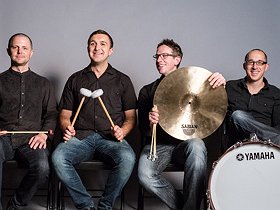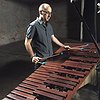Part 2
There are many descriptions of the ideal state of mind for being creative. What is it like for you? What supports this ideal state of mind and what are distractions? Are there strategies to enter into this state more easily?
As I said above, I believe the answer is time. I need time to think. I need space to breathe. I need time to let ideas germinate inside my head and then manifest in actual sound. I have found that driving to gigs and being stuck in the famous Los Angeles traffic has helped me immensely. I use my time, by myself, driving to gigs or rehearsals to think and problem-solve. It sure beats listening to bad radio!
How do you make use of technology? In terms of the feedback mechanism between technology and creativity, what do humans excel at, what do machines excel at?
I’m wary and somewhat skeptical of technology. While I definitely benefit from it and use it, I still prefer a pencil, paper, and a good ol’ face-to-face meeting. With that said, being able to Skype or Facetime a composer is truly invaluable in problem-solving (which then results in a great savings in time). LAPQ has had many meetings via Skype or Facetime with composers and these meeting have helped us better prepare and interpret new pieces.
Collaborations can take on many forms. What role do they play in your approach and what are your preferred ways of engaging with other creatives through playing together or just talking about ideas?
Collaborations are everything! I absolutely need and seek out collaborations. In terms of how we work together, I like to get together and play and talk! I also do a great deal of research ahead of new collaborations, learning about the new artists I will be working with.
How is preparing music, playing it live and recording it for an album connected? What do you achieve and draw from each experience personally? How do you see the relationship between improvisation and composition in this regard?
They are definitely all related, though in modern times I’ve found that due to advances in recording technology, the recording itself can be quite different from a live performance. This isn’t a bad thing; rather, it allows for versions of compositions that are closer and closer to what the composer has in his or her mind. However, this does take away (sometimes) from the organic quality of musical interpretation. It is pretty awesome to listen back to a recording of a piece you played on, like Beyond, and be blown away by the sound quality. Modern technology is crazy!
How do you see the relationship between the 'sound' aspects of music and the 'composition' aspects? How do you work with sound and timbre to meet certain production ideas and in which way can certain sounds already take on compositional qualities?
The way I describe this is through a conversation I had with composer and percussionist Bill Kraft. He told me that in the ‘50s and 60s, when he was working closely with Stravinsky among other composers, percussionists were few and far between. They were tasked with manifesting the sound heard in the composer’s mind. Fast forward 50 years and there have been major developments in the percussion world, most notably that of technique. However, technical pieces written by percussionists have become standard repertoire. I find this somewhat troubling because then composers are attending concerts and writing for what they hear instead of continuing to push sonic boundaries. In LAPQ we aim to work with composers who are still pushing these boundaries.
Our sense of hearing shares intriguing connections to other senses. From your experience, what are some of the most inspiring overlaps between different senses - and what do they tell us about the way our senses work? What happens to sound at its outermost borders?
Man, this is a deep question! I will have to have a longer think on this, but here are some initial thoughts. A good friend and collaborator of mine, Sarah Belle Reid, got me hooked into the writings of artist Marcel Duchamp. Specifically, he writes about the notion of Infrathin, or the space between. What space? I don’t know. He doesn’t define it further but he did explore it in visual art. Sarah explores it in sound. How do we define the space between notes. What happens in space after the sound leaves our instrument and also leaves our ears? Is it still in the space? So many questions!
Art can be a purpose in its own right, but it can also directly feed back into everyday life, take on a social and political role and lead to more engagement. Can you describe your approach to art and being an artist?
For me, the answer is in community. I try to bring my art out to the community, to audiences who do not normally have exposure to the arts or at least my area within the arts. While I absolutely love and respect new music audiences, these audiences generally already have knowledge and experience within the arts. I believe it is my duty, and the duty of other artists, to reach out of our comfort zone to reach new audiences, which in turn, can expand our reach.
It is remarkable, in a way, that we have arrived in the 21st century with the basic concept of music and performance still intact. Do you have a vision of music and performance, an idea of what they could be beyond their current form?
This is an interesting question, though I would disagree that it is remarkable we have arrived with the concept of music and performance still intact. I believe, and will always believe, that art will always be. Because of this, I am not surprised that the concept of music and performance is still intact. In fact, I don’t expect it to change. Details around the arts will change (funding, performance, audience, etc.), but the arts are such an integral part of human identity that they are not going anywhere!






